Gantt Chart vs. Kanban Board: How to Manage Your Project

Sorry, there were no results found for “”
Sorry, there were no results found for “”
Sorry, there were no results found for “”
As project teams become more globalized and cross-functional, project managers continually reevaluate processes. And it’s a delicate task! Too much change at once can disrupt a team’s productivity, and on the other hand, slow improvements inevitably hurt innovation.
You’ve come across sophisticated tools like Gantt charts and Kanban boards, but you’re not entirely convinced one is the right process solution for your project—and team—needs.
This guide will explain the differences between Gantt chart vs. Kanban board, how to use each for project management, and what points you should consider when choosing.
It’s important to note these two project management tools are not better than the other. How a project management tool is introduced, trained, and adopted makes all the difference to success. The best approach to deciding between a Gantt chart or Kanban board for your project is this:
Gantt charts are best for keeping track of related, complex projects lasting weeks, months, and even years. An everyday use case is a project manager visualizing the progress of their campaigns across multiple teams.
Kanban boards are best used for focusing on continuous workflow, individual task prioritization, and work in progress limits. An everyday use case is software development teams visualizing all work in flight as tasks move through each stage toward completion.
Now let’s look under the hood of each as we continue our Gantt chart vs. Kanban board showdown!
A Gantt chart is a horizontal bar diagram illustrating the start and due dates of a project’s schedule. Gantt charts also show important project milestones and how tasks are dependent on one another. These features help teams plan detailed, complex projects over any time period.
The six main components of a typical Gantt chart are:
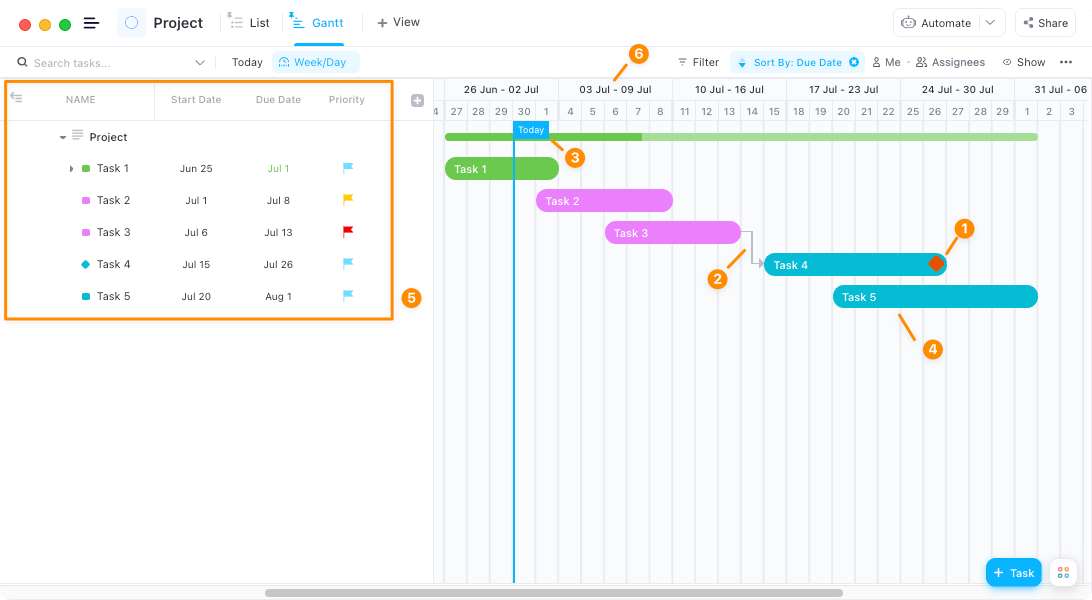
Looking for an alternative to a Gantt visualization? Check out our top 10 Gantt Chart Alternatives.
Fundamentally, a Gantt chart will set up and support your team’s activities, so individual tasks have dedicated time and resources to complete. Here are five reasons to choose a Gantt chart over a Kanban board:
Like the waterfall methodology, Gantt charts clearly outline the task schedule order so team members know if a task is waiting on another task to start or finish before it can begin. For example, a designer’s task to build the campaign’s creative assets cannot start if they don’t have the content draft from a copywriter. The project manager needs to be aware of this timing because the entire project schedule is at risk if work is submitted late.
Bonus: Try our Gantt chart templates for designers.
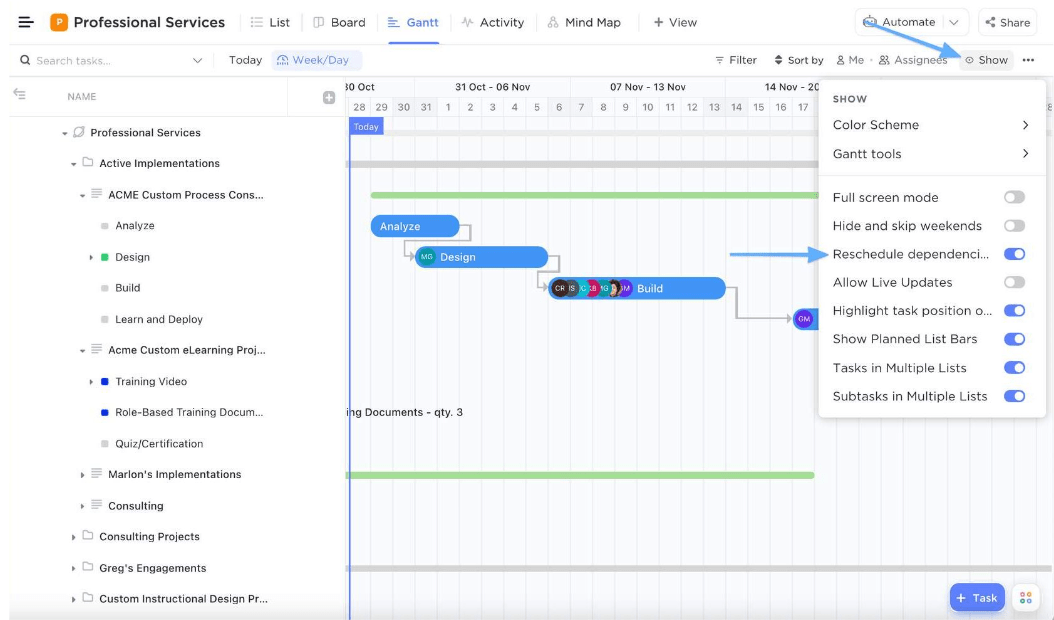
The critical path on a Gantt chart is the chain of tasks crucial to completing your project on time. With the critical path, you can sidestep non-critical tasks. This will help you assign more resources to the critical tasks and shorten completion times.

A Gantt chart is the perfect visual overview to see the big picture while giving insight into a task’s parts. It answers key questions such as:
If you do need to adjust a project’s start and due dates, it’s simple to do on a modern* Gantt chart! Drag and drop a task or the entire schedule to reflect new start/due dates.
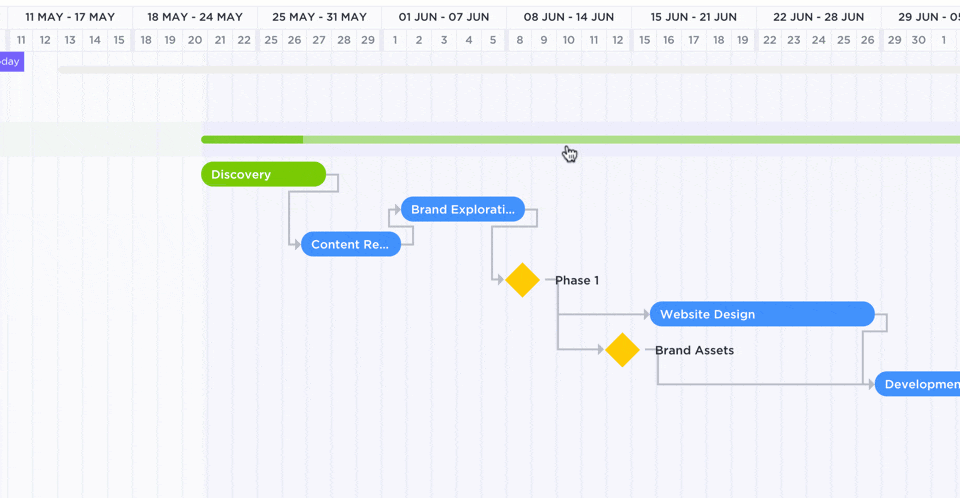
*A modern Gantt chart is a few clicks away! Plan time, manage resources, visualize dependencies, and so much more with the Simple Gantt chart template in ClickUp!
✅ Gantt chart pros
❌ Gantt chart cons
Check out our full list of Gantt Chart Templates!
A Kanban board is a workflow visualization tool best for projects without the need for prioritization or dependency strategies. Instead, Kanban boards help limit the work in progress per workflow status. A card (representing the task) moves through each column (representing the workflow status) from left to right until it reaches the DONE status.
Kanban boards are built for continuous delivery, so start and due dates aren’t as strict on these boards compared to Gantt charts.
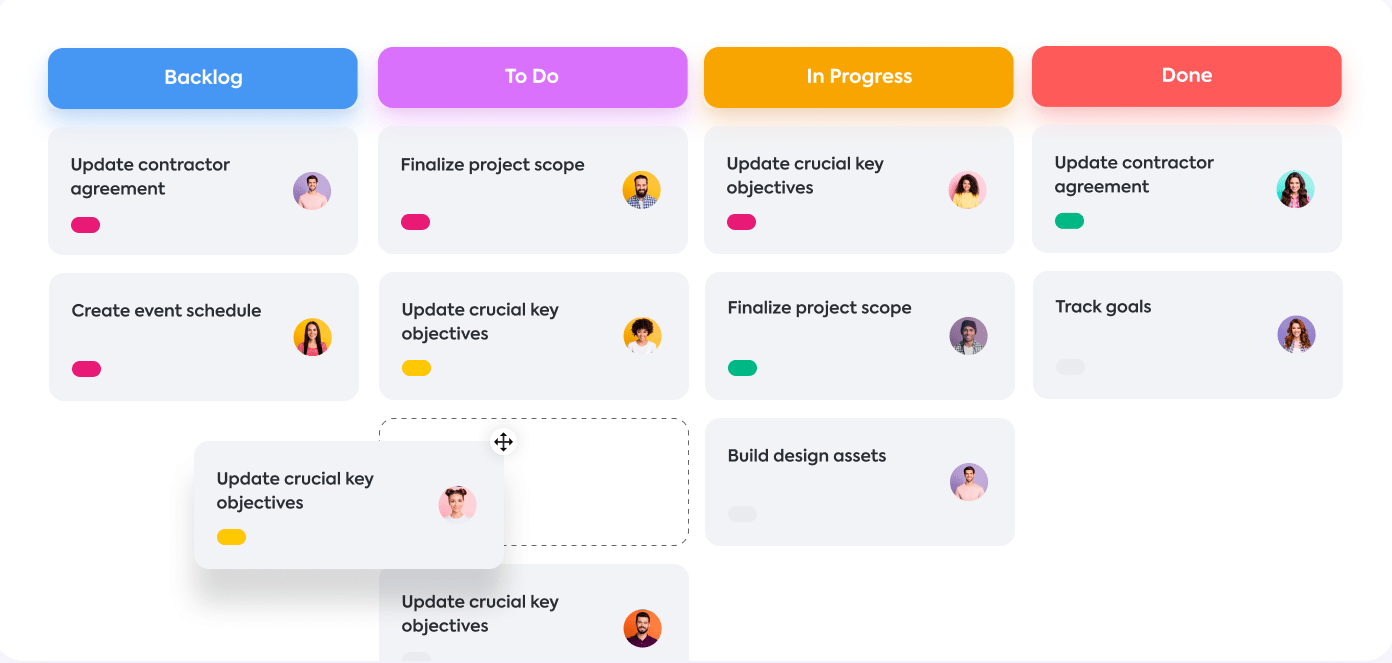
The three main components of a Kanban board are:
Kanban boards are perfect for project teams needing to standardize processes to maintain efficiency as tasks move through each stage. Here are five reasons to choose a Kanban board over a Gantt chart:
Does a task begin when the request is received or when the team begins the work? The person requesting might say it’s the former, but in a Kanban system, it favors the latter.
The commitment point is the act of pulling a Kanban card into the workflow to begin the work. This means all the knowledge is collected, the assignee is well-prepared to kick off the task, and the clock starts. When a task is completed, it has reached the delivery point.
So, where are tasks kept when they’re not ready to commit? They’re stored in a special column at the beginning of the Kanban board called the backlog. The backlog is a space for project managers to pull in work based on priority, clarity, and feasibility. This helps the team plan, allocate, and monitor what’s happening at any given time. (More on this in No. 3!)
Agile or predictive approaches to projects work best with a Kanban system because it improves the consistent delivery. For example, a project manager easily sees where there are too many tasks building up in a column or where tasks are spending a little too much time at. When the bottleneck is spotted, the project manager takes action to remove the bottleneck and maybe discover a potential process improvement too:
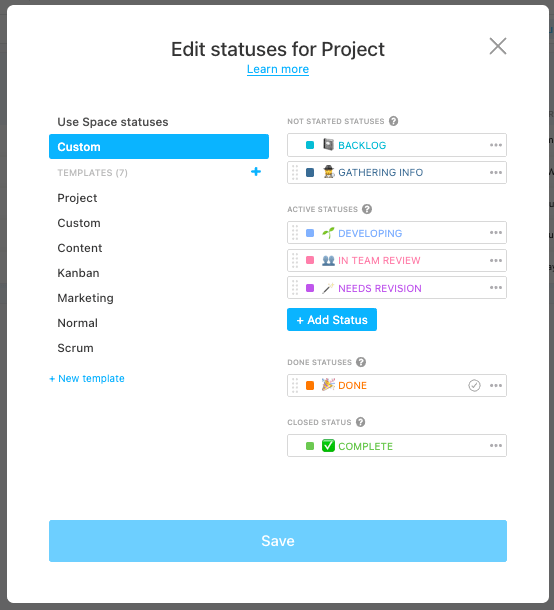
It happens to all of us—we say yes to every incoming request without fully understanding the scope of work. If you need a polite way of saying “no,” this is where Kanban boards come in clutch!
Work in progress (WIP) limits facilitate resource management—the process of planning, allocating, and monitoring your resources in the most efficient way possible. On an intutitive* Kanban board, WIP limits set the maximum number of tasks allowed in a column and alert when it exceeds the limit.
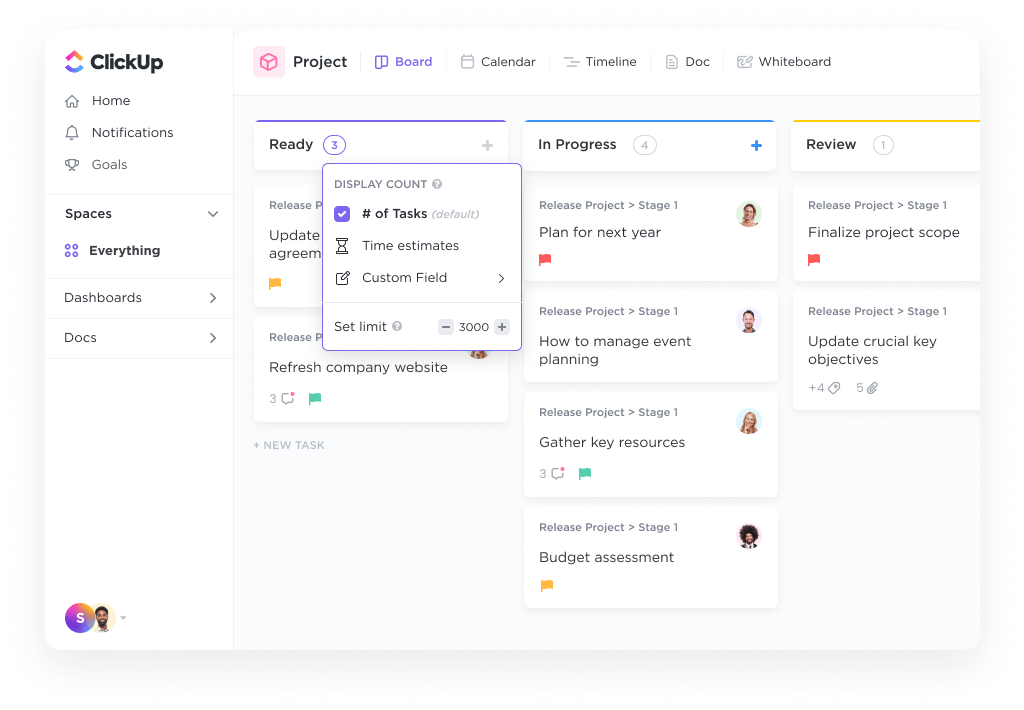
*Intuitive Kanban boards in ClickUp are ready to use right now! Try the powerful drag-and-drop feature in the Kanban template and make your project teams even more productive.
✅ Kanban board pros
❌ Kanban board cons
With your new knowledge about Gantt charts and Kanban boards, now it’s time to decide which project management software will make the workflow process experience stress-free! Other platforms would make you choose between Gantt charts or Kanban boards, but at ClickUp, we say, “Have it all!”
ClickUp is an all-in-one productivity platform where teams come together to plan, organize, and collaborate on work using tasks, Docs, Chat, Goals, Whiteboards, and more. Easily customized with just a few clicks, ClickUp lets teams of all types and sizes deliver work more effectively, boosting productivity to new heights! And views are the secret sauce in ClickUp.
Views are like lenses for your glasses. Each view provides a unique perspective and can also be adjusted to match individual and team preferences. With different ways of grouping, sorting, and filtering, you get complete control of how you see your tasks.
Check out our Gantt view tutorial for tips and tricks to get started with Gantt views! ⬇️
Learn how to use the Board view to your advantage and get pro tips to help you move faster throughout your day! ⬇️
ClickUp has over a dozen ways to organize and visualize tasks and other work. In the realm of Gantt chart vs. Kanban board, both are great tools in their own environment, but they are even more powerful in ClickUp. ⚡️
Opportunities to improve how you manage your projects are waiting inside ClickUp. Are you ready to change the direction of your productivity? Sign up for free today!
If you liked this comparison, go ahead and check out our Pert vs Gantt breakdown!
© 2025 ClickUp